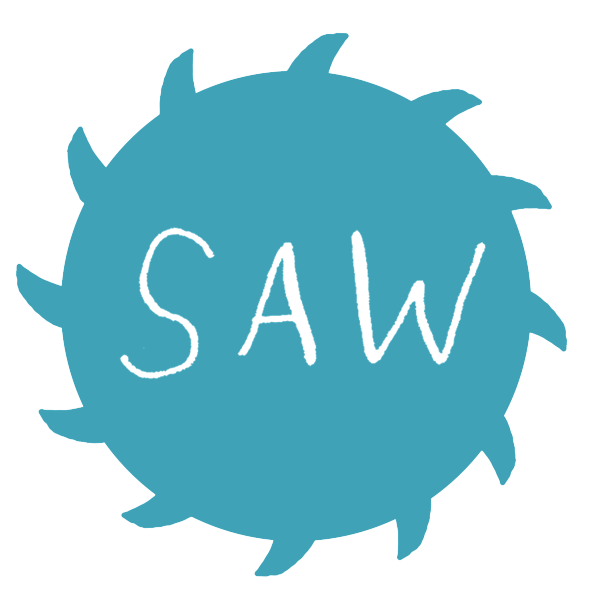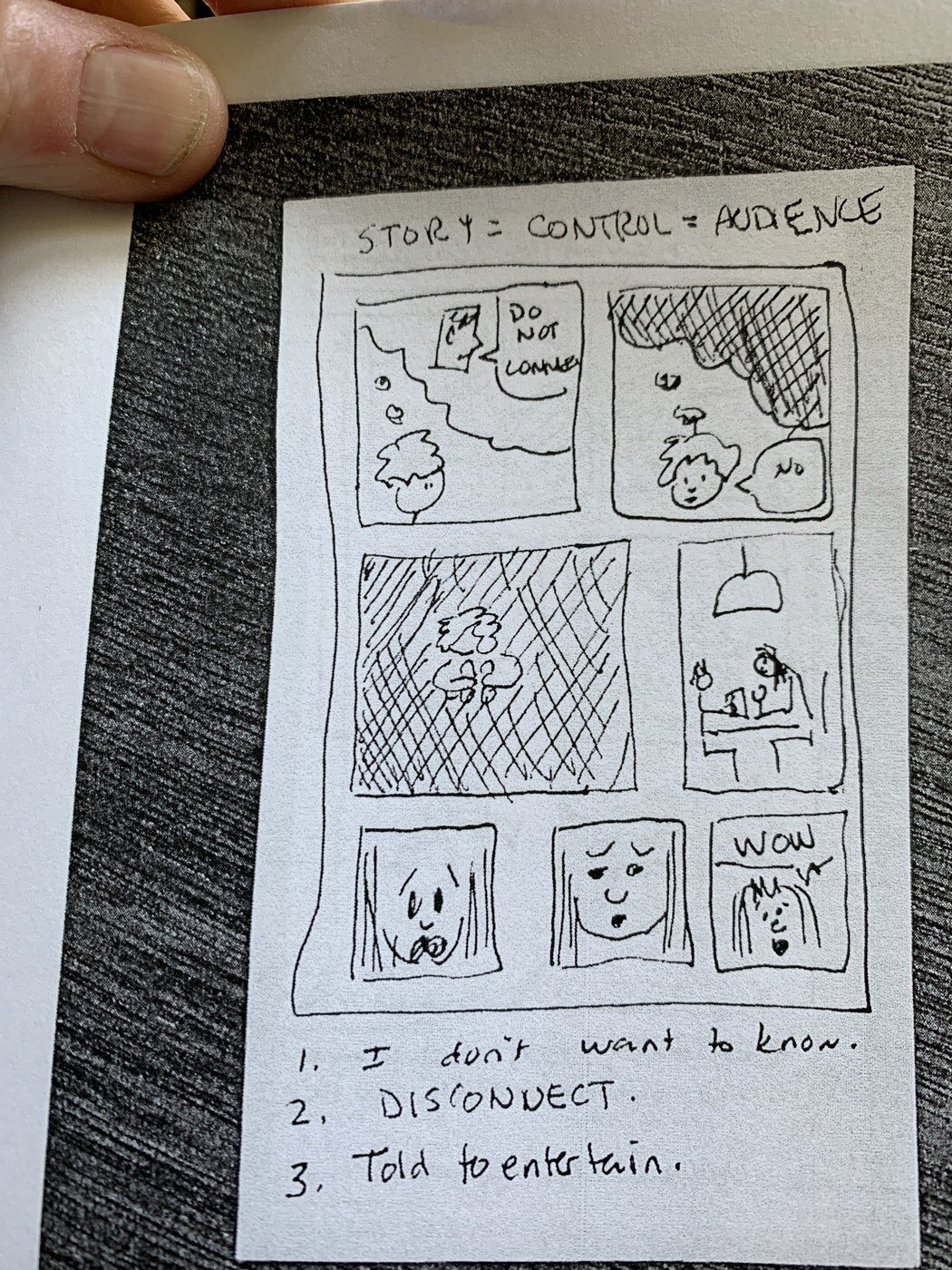Using Cards to Brainstorm
See how Instructor Beth Trembley uses cards to brainstorm!
Beth writes,
“In my recent online workshop about project/time/workflow management--you can find a recording and links to the Google Slides at this link
--I mentioned that I used 3x5 cards to create my very first and REALLY ROUGH draft of my graphic memoir. This method helped me get my story down pretty fast, work out the big picture details of storytelling and character development, and kept me from getting precious about art or script until I had that other stuff sort of worked out.
A few people have asked me to say more about that process. So here is a bit more detail.
Loads of folks like thumbnail pages. Usually that's a piece of 8.5 x 11 paper with a12 or 16 blank rectangles on it, with some space to write underneath, in which people can work out very quickly possibilities for what their pages might look like. Working small (these are often just an inch or two high) keeps you from fussing. You don't have space for detail so you can't include it. You are just getting the shape of the visuals on the space and making a few notes about what is going to happen on the page. Here is an example of the sort of thing I'm talking about:
Source: https://www.deviantart.com/brianatkins/art/Comic-Book-Thumbnail-Template-421679454
I tried using this sort of thing and for me this didn't work for a few reasons:
1. I can't draw that small. I can't think that way. I'm just not secure enough with my visuals.
2. I needed to be able to make more notes about each page than this had space for. Not a lot of notes, but more.
3. This lacked the flexibility I really really need at the beginning stages. I make lots of false starts, have loads of ideas that I think better of and so on. And I found that using a page like this messed me up entirely. If I had something I didn't like, it was a pain to erase. Plus I hate working in pencil. I could redraw in a later blank, but then everything was out of order. I could redraw on another blank page and cut and paste the new version over the old one, but sheesh, now I need scissors and tape or glue and it just felt unwieldy and fussy and FOR ME what I want in this early stage of thinking/drafting is speed, fluidity, and flexibility.
So I decided to try the same basic thing, only on 3x5 cards. I could have cut up copy paper and it would have worked fine. But cards are pretty cheap (you can get them in batches of 1000 on amazon for remarkably little), and they have a bit more stiffness than cuts of copy paper, which I thought would work better for the shuffling and rearranging I imagined they would go through.
So what I did was this:
1. Each 3x5 card is a page of my draft, a page of my graphic novel in progress.
2. I would draw on the card (I used the blank side), the shape of the page as an outside border. This would leave space at the bottom of the page for some special notes.
3. Inside that page shape, I would draw what I imagined would be the layout of my page, with VERY quick, basic shape sort of drawings to indicate my ideas about what visuals would be on the page. Very few words, if any. This allowed me to look at overall page layout and the ideas I had for shots.
4. At the top of the page I would write a "headline." Basically a word or phrase telling me what this page is about. I read advice somewhere long ago and I have heard it repeated that it helps, especially in the early drafting stages, to think of each page of your comics as a paragraph. It has one big thing to convey. What is it?
5. At the bottom of the page I would write the words or phrases that made up the page's main idea. So, in the same way that a paragraph is made up of sentences, a page is made up of tiers (or rows) of panels. I was advised to think of each tier as a sentence, at least in the early stages.
So, when I finished a card (which I could do anywhere between 5 and 10 minutes) it would look like this:
You can see the line indicating the overall page, the panels, the headline or "paragraph" topic at the top, and the list of ideas for each tier at the bottom.
You can see I'm using very rudimentary images. Still, I am getting enough information to consider panel shapes and movement, and "camera" shots.
Now odds are good that when you look at it, you have no idea what this page means. But that's okay because this draft, these thumbnails, are only for you. As long as they make sense to you and are helping you work out your ideas, they are gold! I know EXACTLY what this card means... and I created it in September of 2018. I haven't used this page/idea in my book, so I haven't seen it in nearly two years, but I know exactly what I was thinking about including.
Here are a few more examples, the next three pages in this early rough draft.
Look at how scribbly and rudimentary those drawings are! FAST FAST... my goal was to work out the story as fast as I can. I know of no better way (at least that I can do) to get the clay made so that you can start to work with it. Get it down, get it drafted, and then you have something to work with !
The advantages of this for me are big.
1. It's cheap.
2. It's flexible. I can arrange and rearrange pages easily as I think about the order of things.
3. It's not too precious. I can draw one and if I decide it is definitely not worth keeping, I can rip it in half and toss it dramatically over my shoulder, then draw a new one. The ripping and tossing is really fun.
4. It's fast. If I'm not sure about how I want to structure a page, I can draw three or four versions in it in a quarter of an hour, and keep them all to think about.
5. No fiddling with stuff. I just need a pen and my stack o' cards. No glue. No tape. No erasers. No fiddling. This is not the stage of the creative process (for me) in which to fiddle. I fiddle later.
I hope that helps you think about how you might create your early drafts in the best ways to fit your process.”
Thanks for all this, Beth!
I WANT TO MAKE AND READ MORE COMICS!
Do you have a story inside you that’s just itching to come out, but want some guidance to help push it out?
Learn more about intensive comics learning with teachers at SAW by checking out SAW’s Year-Long Intensive Program and our Six-Month Graphic Novel Intensive.
Be sure to also check out our Online Courses, since some courses are offered year-round and are always enrolling!
Our Graphic Memoir Intensive runs year round and is always enrolling. It includes access to a vibrant working community, twice-monthly live online check-ins, weekly prompts, and access to SAW’s Monthly Pro Calls!
Our Comics Flow Group, is also year-round and always enrolling and is SAW's MOST AFFORDABLE course option with access to Monthly Pro-Calls!
And, of course, come see what we’re all up to on SAW's Mighty Network anytime!
Cheers,
Karlo





